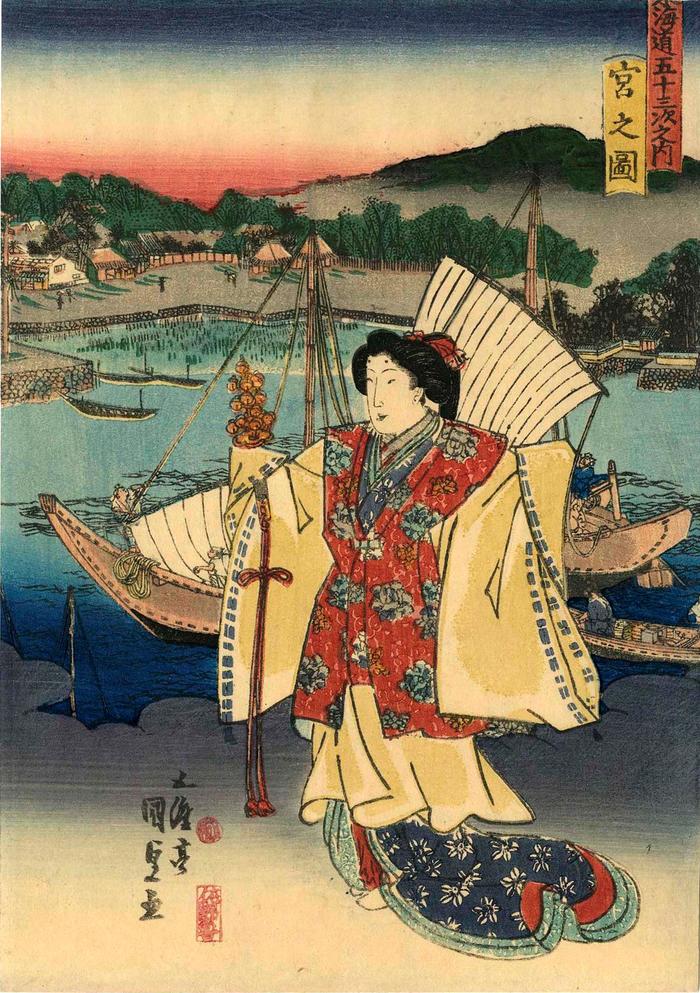Utagawa Kunisada (歌川国貞) / Toyokuni III (三代豊国) (artist 1786 – 01/12/1865)
View of Miya (Miya no zu: 宮之図) from the chuban series Fifty-three Stations of the Tōkaidō Road (Tōkaidō gojūsan tsugi no uchi: 東海道五十三次之内)
ca 1838
Signature: Gototei Kunisada ga (五渡亭国貞画)
Publisher: Sanoya Kihei
Censor's seal: kiwame
Museum of Fine Arts, Boston - published by Moriya Jihei
National Diet Library - published by Moriya Jihei and Sanoya Kihei
Museum für angewandte Kunst, Vienna
Virginia Museum of Fine Art
Ishikawa Prefectural Museum of Art - they date their copy to 1836
Bryn Mawr
Honolulu Museum of Art - published by Moriya Jihei
Berkeley Art Museum and Pacific Film Archive at the University of California
The Library of Congress This print is number 42 in the series. The curatorial files at Museum für angewandte Kunst in Vienna note: "For the depiction of the Miya 宮 station in the background, Kunisada did not use Hiroshige's picture as a template, but created his own picture. It shows the port of Miya in the bay of Ise, from where travelers can take the ship to the next station Kuwana 桑 名. Some larger ships are just entering the port."
****
In Tokaido Landscapes: The Path from Hiroshige to Contemporary Artists, 2011, #43, p. 55, speaking of the original Hiroshige print it says in a text by Sasaki Moritoshi: "The trip by water across Ise Bay from Miya to Kuwana covered 7 ri (about 27 kilometers) and was known as the 7-ri Passage. Here two ferryboats, crammed with passengers, have just lowered their sails as they approach the wharf on the Kuwana side."
Kunisada's chuban Bijin Tokaido (東海道美人) series was first published around 1833, after Hiroshige's famous series was underway but not yet complete.
****
In Tokaido Landscapes: The Path from Hiroshige to Contemporary Artists, 2011, #35, p. 47, speaking of the original Hiroshige print it says in a text by Sasaki Moritoshi: "A daimyo's procession can be seen faintly on the Yoshida Bridge across the Toyo River. In the foreground is Yoshida Castle. The plasterers at work on he roof are facing different directions so they do not appear to be having a conversation. There is also a tiny figure of a worker, climbing the scaffold and shading his eyes. But the sky and the river are so expansive, if he were to shout, his voice would be swallowed by the void." The Kunisada print has eliminated the worker climbing the scaffolding.
****
According to Hiroshige: l'art du voyage, Paris, 2012, p. 89 it says that the trip on land between the Miya and Kuwana stations was either 16.7 miles to 24 miles long. However, the trip by boat took just a little over two hours and therefore was the preferable way to travel between them.
In Kuwana the local specialty was cooked hamaguri (蛤) or clams. It has been suggested that Hiroshige subtly recreated as clam shell partially opened by the way he presented the sails on the boats. [This explanation seems reasonable to us, although we would not have known this without the accompanying test in Hiroshige: l'art du voyage.
****
Muneshige Narazaki in Masterworks of Ukiyo-e: Hiroshige, the 53 Stations of the Tōkaidō (p. 74) noted: "One of Hiroshige's finest prints, this depicts the crossing by water from Miya to Kuwana, a distance of about seventeen miles. Two boats have drawn in their sail as they approach the Kuwana shore, against a background of Kuwana Castle, while other boats, sails high, may be seen in the distance. Situated at the point where three rivers (the Ibi, the Nagara, and the Kiso) flow into the Bay of Ise, Kuwana was once a major port; it is now (with a population of some seventy-five thousand) a factory town as well as a seaside resort in summertime. Nearby are a number of sites of tourists interest, including the famous Tado Shrine."
****
In Hokusai and Hiroshige: Great Japanese Prints from the James A. Michener Collection, Honolulu Academy of Arts, 2nd printing 1999, p. 205 it says: "Miya, the third largest station on the Tōkaidō Road after Ōtsu and Fuchū, was also the town of the famous shrine of Atsuta, where one of the three treasures of the emperor, the sacred sword, is kept. Today Miya is merged into the great city of Nagoya, but has remained as Atsuta ward, having taken the name of the shrine."
Later the text continues: "From Miya two roads branched off inland: one toward Saya and the other toward Mino province. The Tōkaidō Road itself stopped at Miya, and travelers took the water route to Ise Bay for about 17 miles (7 ri) to Kuwana. Between Miya and Kuwana there were too many rivers to cross, particularly the large Kiso and Nagara rivers that empty into Ise Bay. Thus the sea route was a reasonable solution."
****
Sebastian Izzard in Hiroshige: an exhibition of selected prints and illustrated books on page 26 tells us that "In the Edo period [Miya] was the largest station of the Tōkaidō, with approximately two hundred and fifty inns."
****
Illustrated in a small color reproduction in Kunisada's Tokaido: Riddles in Japanese Woodblock Prints by Andreas Marks, Hotei Publishing, 2013, page 73, T24-42.
Sanoya Kihei (佐野屋喜兵衛) (publisher)
landscape prints (fūkeiga 風景画) (genre)
